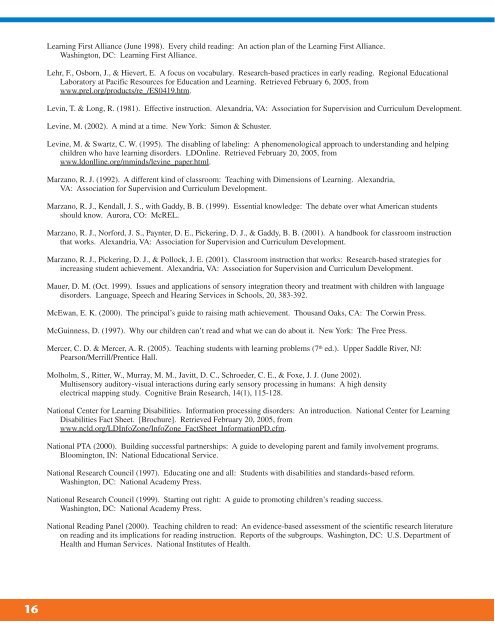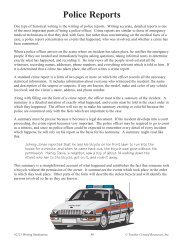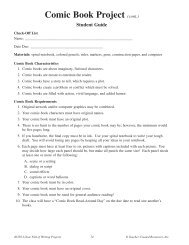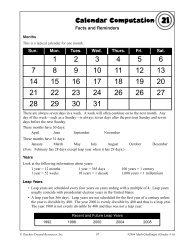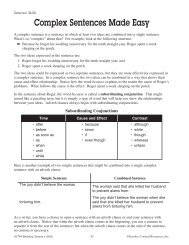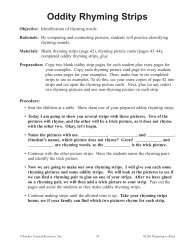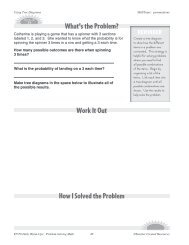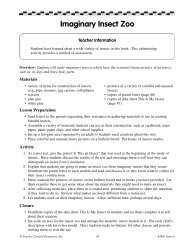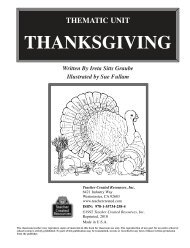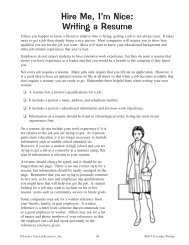Scientifically-Based Evidence - Fisher Scientific
Scientifically-Based Evidence - Fisher Scientific
Scientifically-Based Evidence - Fisher Scientific
You also want an ePaper? Increase the reach of your titles
YUMPU automatically turns print PDFs into web optimized ePapers that Google loves.
Learning First Alliance (June 1998). Every child reading: An action plan of the Learning First Alliance.Washington, DC: Learning First Alliance.Lehr, F., Osborn, J., & Hievert, E. A focus on vocabulary. Research-based practices in early reading. Regional EducationalLaboratory at Pacific Resources for Education and Learning. Retrieved February 6, 2005, fromwww.prel.org/products/re_/ES0419.htm.Levin, T. & Long, R. (1981). Effective instruction. Alexandria, VA: Association for Supervision and Curriculum Development.Levine, M. (2002). A mind at a time. New York: Simon & Schuster.Levine, M. & Swartz, C. W. (1995). The disabling of labeling: A phenomenological approach to understanding and helpingchildren who have learning disorders. LDOnline. Retrieved February 20, 2005, fromwww.ldonlline.org/mminds/levine_paper.html.Marzano, R. J. (1992). A different kind of classroom: Teaching with Dimensions of Learning. Alexandria,VA: Association for Supervision and Curriculum Development.Marzano, R. J., Kendall, J. S., with Gaddy, B. B. (1999). Essential knowledge: The debate over what American studentsshould know. Aurora, CO: McREL.Marzano, R. J., Norford, J. S., Paynter, D. E., Pickering, D. J., & Gaddy, B. B. (2001). A handbook for classroom instructionthat works. Alexandria, VA: Association for Supervision and Curriculum Development.Marzano, R. J., Pickering, D. J., & Pollock, J. E. (2001). Classroom instruction that works: Research-based strategies forincreasing student achievement. Alexandria, VA: Association for Supervision and Curriculum Development.Mauer, D. M. (Oct. 1999). Issues and applications of sensory integration theory and treatment with children with languagedisorders. Language, Speech and Hearing Services in Schools, 20, 383-392.McEwan, E. K. (2000). The principal’s guide to raising math achievement. Thousand Oaks, CA: The Corwin Press.McGuinness, D. (1997). Why our children can’t read and what we can do about it. New York: The Free Press.Mercer, C. D. & Mercer, A. R. (2005). Teaching students with learning problems (7 th ed.). Upper Saddle River, NJ:Pearson/Merrill/Prentice Hall.Molholm, S., Ritter, W., Murray, M. M., Javitt, D. C., Schroeder, C. E., & Foxe, J. J. (June 2002).Multisensory auditory-visual interactions during early sensory processing in humans: A high densityelectrical mapping study. Cognitive Brain Research, 14(1), 115-128.National Center for Learning Disabilities. Information processing disorders: An introduction. National Center for LearningDisabilities Fact Sheet. [Brochure]. Retrieved February 20, 2005, fromwww.ncld.org/LDInfoZone/InfoZone_FactSheet_InformationPD.cfm.National PTA (2000). Building successful partnerships: A guide to developing parent and family involvement programs.Bloomington, IN: National Educational Service.National Research Council (1997). Educating one and all: Students with disabilities and standards-based reform.Washington, DC: National Academy Press.National Research Council (1999). Starting out right: A guide to promoting children’s reading success.Washington, DC: National Academy Press.National Reading Panel (2000). Teaching children to read: An evidence-based assessment of the scientific research literatureon reading and its implications for reading instruction. Reports of the subgroups. Washington, DC: U.S. Department ofHealth and Human Services. National Institutes of Health.16


